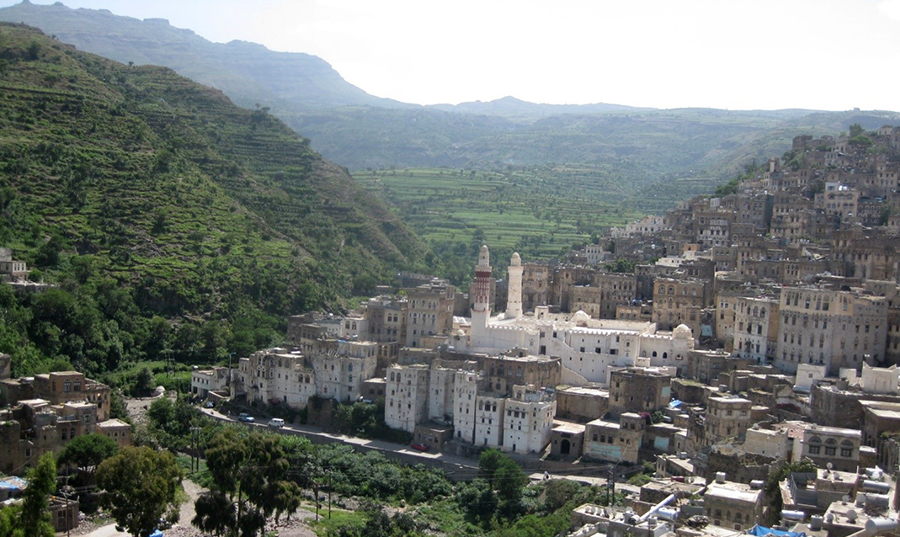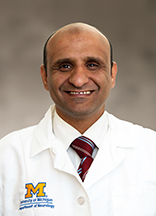Q: Where are you originally from?
Dr. Alakwaa: I am from Sanaa, the capital of Yemen.

Q: Tell us about your research.
Dr. Alakwaa: My research program focuses on the development of novel computational bioinformatics tools in order to analyze and integrate multi-omics data. My overarching goal is to become an independent translational bioinformatics investigator and leader in integrating multi-omics data for the purpose of informing and developing novel targeted therapies.

Q: Can you tell us a little bit about multi-omics?
Dr. Alakwaa: Multi-omics is a type of biological analysis in which the data sets are multiple “omes”, such a genome, proteome, epigenome, etc., so we use multiple “omic” technologies to investigate in a more concerted manner. This allows us to analyze complex biological big data and find new associations, pinpoint biomarkers and better understand disease physiology.
Q: How did you get involved in big data?
Dr. Alakwaa: My experience with Big Data in biomedical science really started when I began my postdoctoral training with Dr. Lana Garmire as a mentor. She is an internationally-known bioinformatics expert in the Department of Epidemiology at the University of Hawaii. My work with her mainly focused on developing computational bioinformatics pipelines for various omics data analysis, including metabolomics, DNA methylation, microbiome, nanostring gene expression data and drug repurposing data. Additionally, I led several major collaborative projects, including the analysis of the metabolomics data using a deep learning approach. My work showed that the biological interpretation of the hidden layer of the deep learning model reveals a better understanding of disease biology than other machine learning algorithms, which led to a first author publication in the Journal of Proteome of Research. Additionally, I led a project to develop a novel algorithm that specialized in personalized pathway measurement and classification prediction models using metabolomics data. This algorithm was published in the Journal of GigaScience.
Q: What made you interested in this area of research?
Dr. Alakwaa: The mechanism of neurodegenerative disease still unknown. I want to know why certain drugs work only in some patients not the others. Analyzing big data from these patients can answer these and many other unanswered questions that will hopefully allow us to find personal treatment approaches for patients with ALS and neuropathy.
Q: In your opinion, what is most exciting about working at the University of Michigan Program for Neurological Research & Discovery?
Dr. Alakwaa: Working with Dr. Feldman is a dream come true. She has a vast knowledge of neurodegenerative disease. I am so proud to be working with her and contributing to the research in her lab.
Q: Where did you get your education and training?
Dr. Alakwaa: I received a BSC, MSC and Ph.D., consecutively in Biomedical Engineering in Cairo University. After I came to the Unites States, I received my postdoctoral training at the University of Hawaii.
Q: What brought you to the United States? Was it a difficult transition?
Dr. Alakwaa: After my PhD, I started my first faculty job as an assistant professor of Biomedical Engineering at the University of Science and Technology, Yemen. In 2015, I, like many other researchers in my country, left due to the eruption of civil war and unstable security situation. I was determined to pursue my career goals, so I moved to the US and immediately sought opportunities to continue to develop and apply my skills. Without prior working experience in the US, I worked as a volunteer researcher at the Henry Ford Health System, under the supervision of Prof. Hamid Soltanian-Zadeh. My work there focused on investigating the association between the f-MRI images and genetic data of Alzheimer’s patients using the ADNI cohort and Canonical Correlation Algorithm.
Q: Are there any accolades we should know about?
Dr. Alakwaa: I received a number of awards while I was working as an assistant professor in my home country Yemen:
2006 Graduate Research(PhD) Fellowship, Yemeni Ministry of Higher Education and Scientific Research
2009 Outstanding Doctoral Thesis in Engineering, Cairo University, Egypt
2010 TWAS-ARO Travel Grant: Selected as a young promising scientists from developing countries to attend BioVision Conference, Lyon, France
2011 U.S. National Academies and Kuwait Institute for Scientific Research (KISR): Selected as the best young scientists, engineers, and medical professionals from the United States and the countries of the Arab League to attend the 1st Arab-American Frontiers of Science, Kuwait
2013 The best Engineering design project in the competition organized by Arab Innovation Network, Amman, Jordan
2014 Principal Investigator, Quality Control of Biosafety Cabinet in Yemen, US Department of State
2014 Travel award to attend the Second Arab-American frontiers of science, Council of Research, Oman
2014 Travel award to attend the 2nd Middle East/North Africa (MENA) Educational Institute on Responsible Science, International Center of Theoretical Physics, Trieste, Italy
2015 Educational Institute on Responsible Science award for the project ” Research Misconduct in Yemen, Government and Private Institutions, Between Fact and Reality”, American National Academy of Science
2015 Conference travel award to attend the First Middle East Biomedical Engineering Conference, American University of Sharjah, United Arab of Emirate
Q: How do you like to spend your time outside of work?
Dr. Alakwaa: Spending time with my family. I have one daughter and three sons, in addition to my wife.
